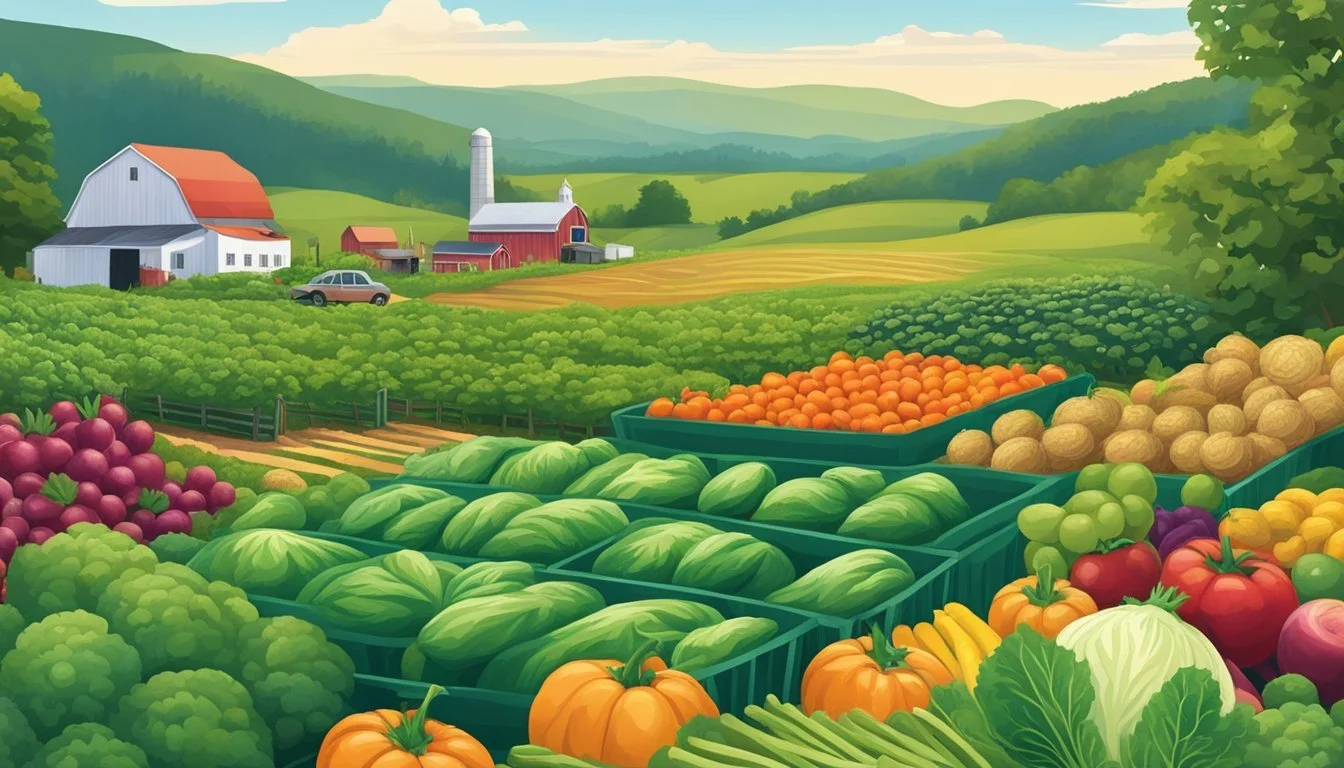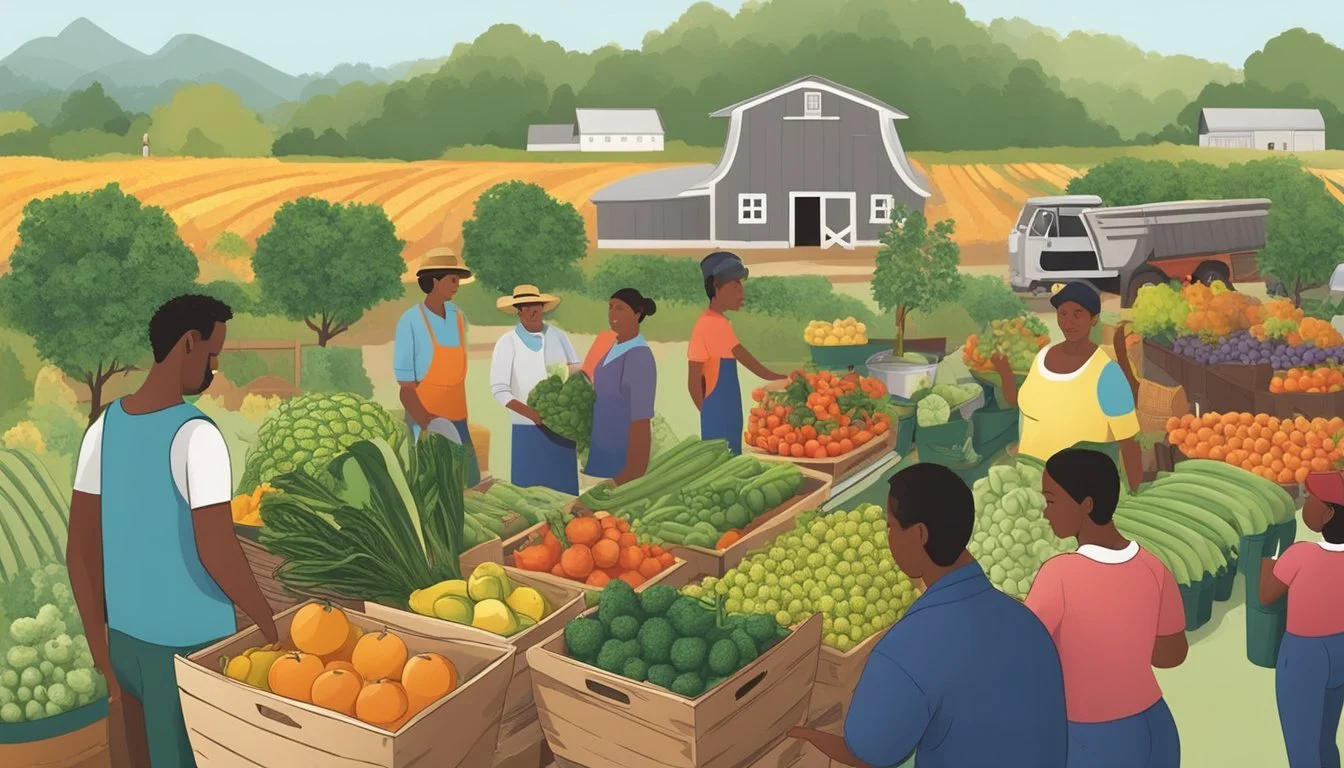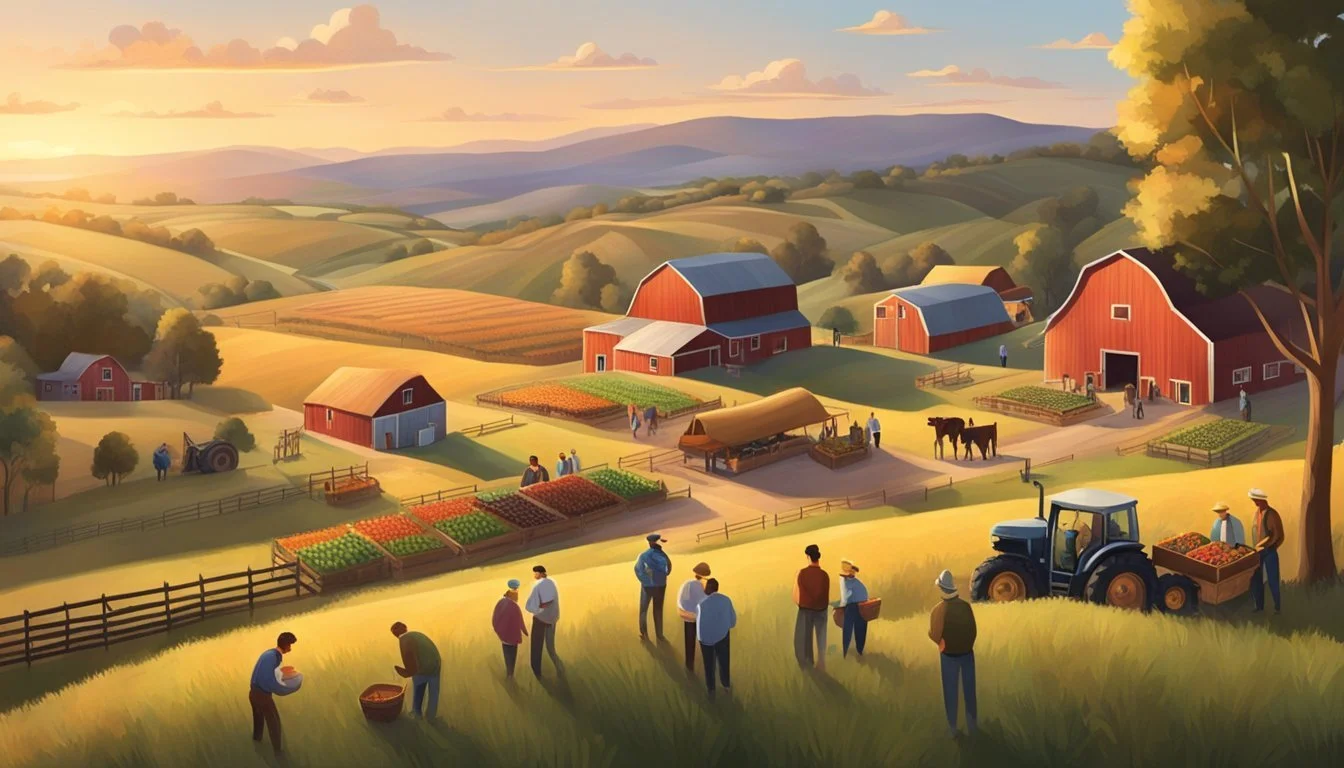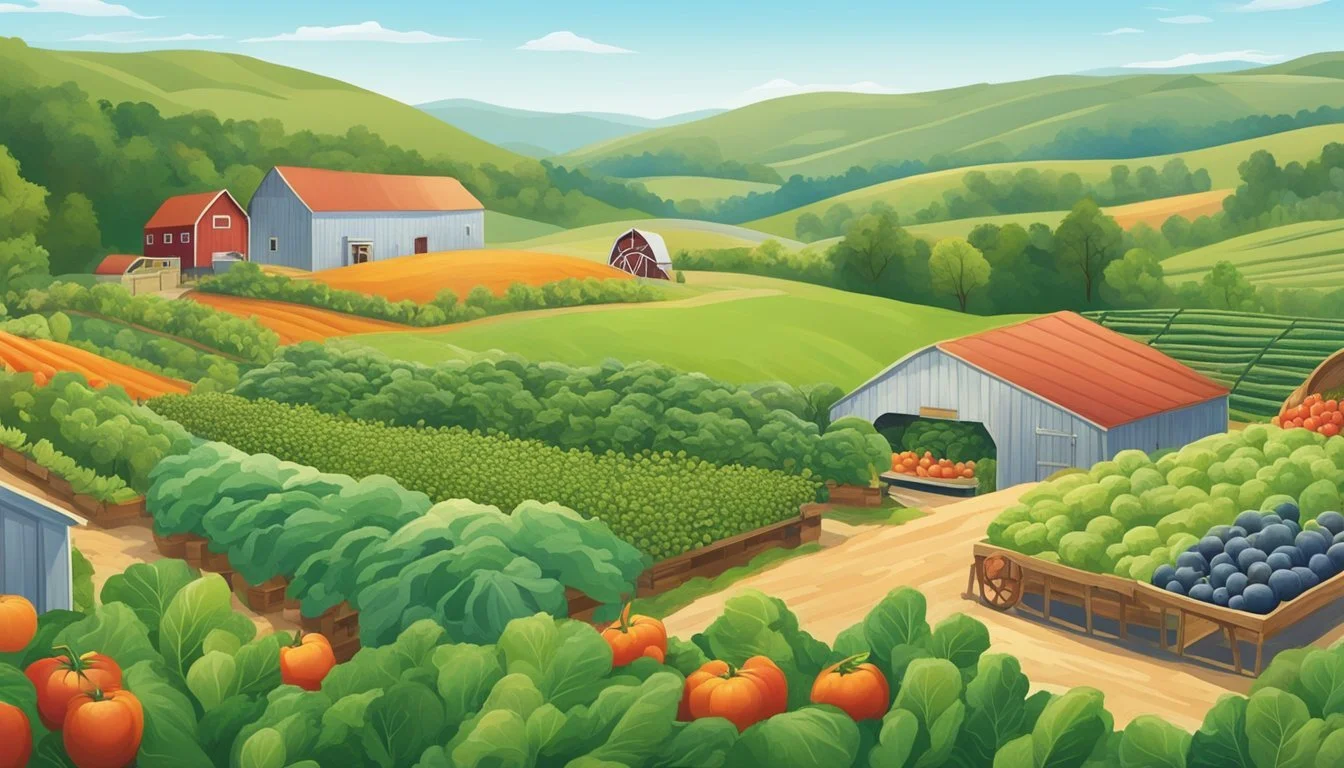Community Supported Agriculture (CSA) in West Virginia
Benefits and Growth
Community Supported Agriculture (CSA) is a model that has reshaped the relationship between farmers and consumers in West Virginia and across the United States. By allowing consumers to purchase "shares" of a farm's harvest in advance, CSAs provide farmers with a stable income and significantly reduce the financial risks associated with agriculture. Participants receive fresh, local farm products on a regular schedule, usually weekly, throughout the farming season. Introduced in the United States in 1985, the CSA model has gained traction for its support of local economies and its role in promoting sustainable agricultural practices.
In West Virginia, CSAs contribute to the cultivation of a robust local food system by encouraging the community's engagement with regional farmers. The state's varied terrain provides a unique backdrop for a diverse array of produce offered through CSA shares. The typical offerings may include vegetables, fruits, and sometimes additional farm products such as eggs or dairy. These arrangements foster a closer connection between West Virginians and the food on their tables, as consumers become intimately aware of the source of their food and the methods used to grow it.
The impact of Community Supported Agriculture in West Virginia is multifaceted, supporting not just the economic stability of local farms but also contributing to food security and healthier lifestyle options for residents. By partaking in CSAs, West Virginians actively partake in a sustainable food economy, ensuring the continuity of local farming traditions and environmental stewardship.
History of CSA
Community Supported Agriculture has evolved from its nascent stages in Europe to a widely recognized model in the United States. West Virginia has actively participated in this movement, reflecting its nationwide growth and importance.
Origins and Founders
The concept of Community Supported Agriculture (CSA) has its roots in Europe, but it was crystallized in the United States by two pioneering figures. Robyn Van En and Jan Vander Tuin are credited with bringing CSA into the mainstream consciousness. Robyn Van En co-founded one of the first known CSAs, Indian Line Farm in Massachusetts, during the mid-1980s. In tandem, Jan Vander Tuin introduced the CSA model at Temple-Wilton Community Farm.
CSA Movement in the United States
The CSA movement in the United States saw significant growth since its introduction. After the establishment of farms in Massachusetts by Van En and by Vander Tuin in the other Northeastern states, the concept began spreading across the country. By the early 21st century, the model had gained popularity, involving thousands of farms and providing direct support to small-scale farmers.
West Virginia's Involvement
West Virginia's agricultural sector embraced CSA, recognizing its potential for economic support and sustainability. CSAs allowed West Virginia farmers to maintain the state’s tradition of family farming by ensuring stable markets for their products. Local communities benefit from fresh, local farm goods, underscoring the symbiotic relationship between farmers and consumers within the CSA model.
CSA Model Overview
Community Supported Agriculture (CSA) in West Virginia represents a pivotal relationship between local farmers and community members. The structure of CSA is founded on mutual commitment: consumers subscribe to the harvest of a farm, and farmers provide a predictable supply of fresh, local produce throughout the farming season.
How CSA Works
In the CSA model, members purchase subscriptions, often referred to as shares, from local farms. These shares are typically bought before the farming season begins. The pre-payment ensures that farmers have the necessary funds to cover the early season's production costs. In return, throughout the growing season, members receive weekly or bi-weekly deliveries of farm products. This system is integral to the local food system as it bridges the gap between consumers and producers.
Membership and Shares
The membership in a CSA is signified by the purchase of a share. The size and price of these shares can vary, with options often available for individuals or families. A standard share might cost between $400-$700 annually, and it provides a consistent quantity of produce which is usually suitable for a family of four. Some farms offer different levels of membership depending on the amount of produce the consumer wishes to receive, and payment can either be made in lump sum or installments.
Shared Risk and Rewards
One of the fundamental principles of the CSA is the notion of shared risk and shared rewards. If a season is bountiful, members benefit from the abundance of crops. Conversely, if the season faces challenges such as bad weather or pests, the quantity of produce may decline, and the members bear a portion of the risk. This shared risk encourages a deeper connection between the consumer and the farming process, fostering a community that supports local agriculture through the ups and downs inherent in farming.
Benefits of Joining a CSA
Community Supported Agriculture (CSA) offers significant benefits for consumers, farmers, and the environment. These benefits range from enhancing food security and nutrition to fostering a stronger sense of community and reducing the carbon footprint associated with food production.
For Consumers
Consumers participate in CSAs for a variety of advantages. They gain access to fresh, seasonal produce that often surpasses store-bought alternatives in flavor and nutrition. Joining a CSA allows consumers to support local farmers and the local economy, ensuring the longevity of local food systems. There is also a cost benefit, as bulk upfront payments for a season's worth of produce can be more budget-friendly, especially for low-income households. Consumers enjoy a direct relationship with their food source, which can lead to a greater appreciation for the food on their table.
Food Security & Nutrition: CSA enables consumers to secure a regular supply of healthy, nutritious foods.
Supporting Local: By participating in a CSA, individuals directly contribute to the financial health of local farms.
Seasonal Variety: Consumers experience a diverse array of produce corresponding with the local growing season.
For Farmers
Farmers benefit from the CSA model through financial stability and a guaranteed market. The prepaid CSA shares provide farmers with upfront capital to cover the initial costs of the growing season. This economic arrangement can be particularly crucial for the viability of small-scale farms. In addition, CSA allows farmers to build personal relationships with their consumers fostering a sense of community and shared responsibility.
Financial Security: Farmers receive funds early on, which helps in planning and managing farm operations.
Community Connection: Establishing a strong relationship with the community can lead to a loyal customer base and valuable feedback.
Environmental Impact
The CSA model contributes positively to the environment by promoting sustainable farming practices that often result in lower greenhouse gas emissions. The localization of food distribution reduces the need for long-haul transportation and the associated carbon footprint. Furthermore, the emphasis on organic or low-impact farming techniques enhances soil health and biodiversity.
Reduced Emissions: Less transportation means a decrease in carbon emissions linked to food distribution.
Sustainable Practices: Farmers may employ methods that enhance soil retention and water conservation.
By participating in CSAs, individuals can enjoy fresher, more diverse foods while supporting local agriculture and contributing to a healthier environment.
Key CSA Farms in West Virginia
West Virginia has a range of Community Supported Agriculture (CSA) farms that offer fresh, locally grown produce directly from farmers to consumers. Notable among them are Evans Knob Farm in Bruceton Mills and Round Right Farm in Terra Alta.
Evans Knob Farm
Located in Preston County, Evans Knob Farm has been dedicated to organic farming methods and was previously certified organic. Consumers can find their produce at the Evans Knob Farm stand or through their CSA subscriptions, which distribute a variety of vegetables grown on the farm.
Address: 498 Walt Teets Road, Bruceton Mills, WV
Phone: 304-379-2002
Website: Evans Knob Farm
Terra Alta's Round Right Farm
Round Right Farm is another establishment embracing the CSA model. Operated by Steve & Sunshine Vortigern, this farm emphasizes sustainable practices and offers a plethora of fresh produce to its CSA members.
Location: Terra Alta, Preston County, WV
Products: Assortment of vegetables and more
More Info: Knowledge about exact contact details or further specifics might be limited based on the information provided.
Other Notable CSA Farms
West Virginia is also home to other CSA farms worth mentioning. These include Hudson Farms in Charleston, which collaborates with various growers including Berea Gardens, to provide a multi-farm CSA approach. Additionally, farmers markets like the South Morgantown Community Farmers Market provide platforms for different CSAs to connect with the local community.
CSA Collaborations: Hudson Farms with other growers
Farmers Market: South Morgantown Community Farmers Market
County Involved: Kanawha County for Hudson Farms
CSA farms play a pivotal role in enriching the local food system by offering residents access to farm-fresh foods while supporting local agriculture.
Challenges Facing CSA in West Virginia
Community Supported Agriculture in West Virginia faces several impediments related to economics, distribution, and consumer engagement. These challenges impact the viability and growth of CSA within the state.
Economic Issues
Economic obstacles pose significant challenges for Community Supported Agriculture. Production costs can be high, as local farmers often struggle with obtaining the necessary funds to invest in their farming operations. Limited access to affordable loans or government subsidies inhibits the ability to scale up and provide competitive pricing. Additionally, local markets can be saturated, limiting the revenue potential for CSA shares, as they compete with traditional retail options.
Distribution and Logistics
The distribution of CSA products throughout West Virginia can be hindered by the state's rugged terrain and rural landscape, which complicates logistics. Farmers must navigate transportation issues which can lead to increased distribution costs and delays, thus affecting the freshness of produce upon delivery. Moreover, the lack of established services to facilitate distribution to a widespread customer base can limit CSA reach, especially in remote areas where potential subscribers reside.
Consumer Awareness and Education
Consumer awareness is crucial for the success of CSA programs, as the model relies heavily on community participation. However, local West Virginians may not be fully educated on the benefits of CSA and the importance of supporting local agriculture. This may lead to a lack of engagement and a smaller customer base. Furthermore, CSA operators must address questions and concerns regarding the variety and volume of produce, which may deter potential subscribers who are unfamiliar with seasonal eating or the concept of sharing risk with the farmers.
Impact of CSA on Local Markets
Community Supported Agriculture (CSA) in West Virginia plays a significant role in influencing local markets by reinforcing direct sales and invigorating the local economy. It also enhances food accessibility for the community.
Direct Sales and Farmers Markets
CSA programs facilitate direct sales from producers to consumers, establishing a strong presence in West Virginia's farmers markets. Farmers benefit from the certainty of pre-sold shares, contributing to financial stability and reducing marketing costs. In return, consumers receive fresh, locally produced food items, fostering a transparent and accountable food source channel.
Local Producers engage in direct sales
Consumers gain access to fresh produce
Local Economy Boost
The infusion of CSA into local economies has rippling effects. According to research, customers at West Virginia farmers markets also engage with nearby businesses, resulting in substantial collateral spending. One study estimated a nearly $965,788 impact on neighboring businesses from three farmers markets alone. This spending substantiates the role of CSA and farmers markets as anchors for local economic development.
Average Expenditures: Consumers spend between $75.99 to $116.29 at nearby businesses.
Economic Impact Estimation: CSA and farmers markets collectively influence nearly a million dollars in local spending.
Food Accessibility
CSA models have made food more accessible to the West Virginia community by providing a consistent source of fresh produce. The structure of CSA ensures that members of the community can obtain a share of the harvest, which has been pre-purchased and often includes a variety of vegetables and fruits. This system supports food access for different socioeconomic groups and contributes to healthier eating habits.
Harvest Sharing: Consumers purchase "shares" for a portion of the overall harvest.
Healthier Choices: CSA promotes access to diverse, nutritious food options.
CSA Variations and Adaptations
Community Supported Agriculture in West Virginia embraces a diverse array of models, accommodating consumer preferences and incorporating modern technology to enhance the traditional CSA experience. These models range from standard shares to ones tailored for specific dietary needs.
Standard vs. Customizable Shares
Standard shares are the traditional CSA model where participants receive a predetermined assortment of produce each week. This model operates on a basis of shared risk and reward, with members accepting the natural ebb and flow of farming yields. Customizable shares, on the other hand, have emerged as an adaptation of this model, allowing members to select their preferred produce within a given week. This variation caters to individual preferences and reduces waste by ensuring that members receive items they are more likely to consume.
The Role of Technology
Technology has profoundly impacted CSAs, with many farms utilizing online platforms and technology to streamline operations. These advancements include member sign-ups, payment processing, and weekly share management. Farms often use surveys to gather feedback for improving their offerings and customizing the CSA experience. Websites like LocalHarvest serve as a conduit, connecting consumers with CSA programs in their locality and providing detailed information about each farm's practices, share options, and pickup locations.
CSA Programs for Special Diets
CSAs have begun to offer programs tailored to meet special diets and nutrition needs. For instance, farms now provide gluten-free, vegan, or paleo-friendly shares to serve members with dietary restrictions or preferences. By offering these specialized shares, CSAs enhance accessibility and inclusivity, ensuring a broader demographic can participate in the local food system. This adaptation not only supports individual health and wellness but also encourages community engagement around sustainable agriculture.
CSA Around the World
Community Supported Agriculture (CSA) has seen a global uptake as a way to bridge the gap between consumers and their local farmers, affirming the power of shared responsibility in food production.
Comparative Analysis by Country
In the United Kingdom, CSAs play a role in supporting local food movements and sustainable agriculture. Britain's CSA movement is characterized by a focus on building a community around local farms. The Soil Association cites over 100 CSA schemes in the UK, highlighting their emphasis on organic production and biodiversity.
France has taken to the CSA model through what they call "AMAP" (Associations pour le maintien d'une agriculture paysanne), which translates to associations for the maintenance of peasant farming. French CSAs underscore the social solidarity aspect of the model, providing not just food but also a commitment to protect the livelihoods of local farmers.
In China, CSA has evolved differently. The practice often combines traditional Chinese cooperative principles with CSA. Their models vary from small-scale, community-focused operations to larger initiatives that form part of regional food systems. Chinese CSA farms sometimes integrate social programs, like educational efforts to reconnect people with agriculture.
Global Impact of CSA Models
The impact of CSA on a global scale cannot be understated. CSA models have fostered a stronger connection between producers and consumers. The global CSA community shares common values: prioritizing local economies, nurturing social cohesion, and imposing minimal environmental impact.
CSAs often operate as cooperatives, which can be particularly beneficial in developing economies. A cooperative approach ensures that members have a stake in both the risks and benefits of the agricultural process, promoting fair income distribution and a sense of ownership among stakeholders.
Joining a CSA in West Virginia
Participating in a Community Supported Agriculture (CSA) program offers residents of West Virginia a unique opportunity to engage directly with local farms. It allows them to support and foster a relationship with the people who grow their food.
How to Find a Local CSA
To locate a CSA in West Anglia, individuals can:
Explore LocalHarvest or similar directories which list CSAs by location.
Visit the Morgantown Farmers Market at 33 Medical Center Drive, where CSA sign-ups are often available.
Connect with local food co-ops or health food stores that may have information on nearby CSA programs.
What to Consider Before Joining
Before committing to a CSA, prospective members in West Virginia should contemplate:
Share Size: Determine the appropriate share size to meet your household's needs without resulting in wasted produce.
Pick-up Location: Ensure the CSA's pick-up location and schedule are convenient.
Variety of Produce: Understand the typical variety of produce included, which can vary from farm to farm.
Payment Plans: Examine whether the CSA offers payment plans that fit your budget, as upfront costs can be substantial.
Through careful consideration of these aspects, West Virginians can cultivate a rewarding community supported agriculture program experience.
Conclusion
Community Supported Agriculture (CSA) in West Virginia stands as a testament to both the resilience and adaptability of local agriculture. These CSAs embody a mutual commitment between West Virginians and their farmers, forging partnerships that are vital for sustainable food systems.
Current Impact:
West Virginians have provided crucial economic support to family-owned farms.
Fresh, locally-sourced products remain available to communities through these CSAs.
CSAs have strengthened the connection between consumers and the journey of their food from field to table.
Future Outlook:
Continued growth is anticipated as more consumers seek to participate in food origin and support local economies.
CSAs may innovate their distribution and farming practices to address evolving environmental and economic challenges.
The positive trajectory of CSAs in West Virginia could serve as a model for other regions, potentially signaling a nationwide shift towards community-focused agriculture.
In summary, Community Supported Agriculture represents more than just a purchasing agreement; it is a partnership grounded in ecological stewardship and the promotion of community resilience. The future for CSA in West Virginia looks promising, with a likelihood of ongoing support and perhaps expansion, helping ensure the longevity and success of traditional family farming within the state.










